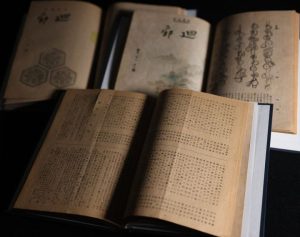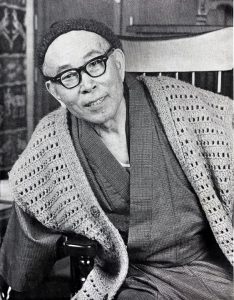Documenting Hiroshima of 1946: April, Haiku group founded for revival of culture
Apr. 24, 2025
by Maho Yamamoto, Staff Writer
In April 1946, Kairo, a haiku group, was founded and led by Akafuji Sugiyama, whose real name was Sakae Sugiyama. He was active as a haiku poet in Hiroshima since before the war and passed away at the age of 73 in 1977. He also launched a monthly haiku magazine Kairo. The group aimed to participate in the movement for the revival of healthy spiritual culture in the ruined city of Hiroshima.
The group chose nature and everyday scenes in their mind’s eye as subjects for their poems, based on the philosophy of describing nature and human beings objectively, as advocated by the famous poet Kyoshi Takahama. The name of the group and its magazine derives from the image of the corridors of Itsukushima Shrine in present-day Hatsukaichi City.
The first issue was an A5-sized 12-page publication. About 100 people submitted their haiku poems, and the judge was Sou Minayoshi, a disciple of Kyoshi. Mr. Sugiyama’s poem was selected: “Inside deer fences, wheat is trodden, on Itsukushima.” Others poems included: “Ravaged by war, got used to home without light, winter,” and “Tree buds glisten, about to unfold, at any moment.”
Mr. Sugiyama and his second daughter, Aiko Yasome, whose real name is Sonoe Sugiyama, then 11, walked around in the burned ruins, posting flyers announcing the magazine’s launch on utility poles. At first, they asked a printing company in Hiroshima to print the magazine, but due to fuel shortages, the company could not cast printing types in time. So, they brought the manuscript by train to a company in Kurashiki, Okayama Prefecture, and managed to publish the first issue. Ms. Yasome is now 90 and lives in the city of Hatsukaichi.
Mr. Sugiyama was also an art teacher at Hatsukaichi Engineering School (now Hatsukaichi High School). He escaped the August 6, 1945, atomic bombing because the building demolition work in Hiroshima was suspended that day. He began going to the city the following day to search for his students. He expressed his feelings at the time in the haiku: “Under the scorching sun, there is nothing I can do, give them love.”
In the August 1946 special issue commemorating the atomic bombing, Kyoshi contributed a haiku that read, “The Bon moon, shed luminous light on the names of the people.” However, he later said that haiku was the literature of paradise, and that the atomic bomb cannot be expressed in haiku. On the other hand, Sugiyama wrote a tanka titled “The abhorrent rainbow” and haiku poems about the days he spent with his younger sister, who was exposed to the atomic bombing, until she passed away.
At its peak, the group had some 400 members inside and outside of Hiroshima Prefecture. Ms. Yasome, a painter and dyeing artist, became its fourth leader. The group published 894 issues of Kairo before bringing down the curtain on it in 2021.
Mr. Sugiyama’s grandson Ryuta Sugiyama, 64, who lives in Tokyo, painted pictures for the magazine’s cover for about 30 years. He said, “My grandfather had many longtime disciples, and my mother began writing haiku late in her life. I believe we have fulfilled the mission from my grandfather.”
(Originally published on April 24, 2025)
In April 1946, Kairo, a haiku group, was founded and led by Akafuji Sugiyama, whose real name was Sakae Sugiyama. He was active as a haiku poet in Hiroshima since before the war and passed away at the age of 73 in 1977. He also launched a monthly haiku magazine Kairo. The group aimed to participate in the movement for the revival of healthy spiritual culture in the ruined city of Hiroshima.
The group chose nature and everyday scenes in their mind’s eye as subjects for their poems, based on the philosophy of describing nature and human beings objectively, as advocated by the famous poet Kyoshi Takahama. The name of the group and its magazine derives from the image of the corridors of Itsukushima Shrine in present-day Hatsukaichi City.
The first issue was an A5-sized 12-page publication. About 100 people submitted their haiku poems, and the judge was Sou Minayoshi, a disciple of Kyoshi. Mr. Sugiyama’s poem was selected: “Inside deer fences, wheat is trodden, on Itsukushima.” Others poems included: “Ravaged by war, got used to home without light, winter,” and “Tree buds glisten, about to unfold, at any moment.”
Mr. Sugiyama and his second daughter, Aiko Yasome, whose real name is Sonoe Sugiyama, then 11, walked around in the burned ruins, posting flyers announcing the magazine’s launch on utility poles. At first, they asked a printing company in Hiroshima to print the magazine, but due to fuel shortages, the company could not cast printing types in time. So, they brought the manuscript by train to a company in Kurashiki, Okayama Prefecture, and managed to publish the first issue. Ms. Yasome is now 90 and lives in the city of Hatsukaichi.
Mr. Sugiyama was also an art teacher at Hatsukaichi Engineering School (now Hatsukaichi High School). He escaped the August 6, 1945, atomic bombing because the building demolition work in Hiroshima was suspended that day. He began going to the city the following day to search for his students. He expressed his feelings at the time in the haiku: “Under the scorching sun, there is nothing I can do, give them love.”
In the August 1946 special issue commemorating the atomic bombing, Kyoshi contributed a haiku that read, “The Bon moon, shed luminous light on the names of the people.” However, he later said that haiku was the literature of paradise, and that the atomic bomb cannot be expressed in haiku. On the other hand, Sugiyama wrote a tanka titled “The abhorrent rainbow” and haiku poems about the days he spent with his younger sister, who was exposed to the atomic bombing, until she passed away.
At its peak, the group had some 400 members inside and outside of Hiroshima Prefecture. Ms. Yasome, a painter and dyeing artist, became its fourth leader. The group published 894 issues of Kairo before bringing down the curtain on it in 2021.
Mr. Sugiyama’s grandson Ryuta Sugiyama, 64, who lives in Tokyo, painted pictures for the magazine’s cover for about 30 years. He said, “My grandfather had many longtime disciples, and my mother began writing haiku late in her life. I believe we have fulfilled the mission from my grandfather.”
(Originally published on April 24, 2025)









